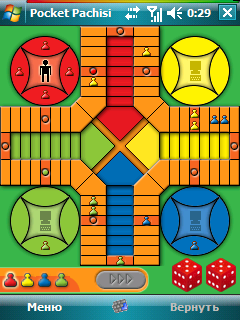
Parcheesi is an American version of the Ancient game of Pachisi, the national game of India, in which you race around a track on the game board, attempting to block your opponents while moving your markers to the goal. The game is also known as Pachisi, Parchisi, Parchesi, and Twenty-Five, and is a descendent of the older game of Chaupar.
Parcheesi, a family classic since the 1860s, is the ultimate race-and-chase board game. The object is take four pawns from start to home, using rolls of the dice to dictate your moves. It sounds easy, but to accomplish your mission you have to first roll a five to even move off of start, and then you must avoid running into blockades and dodge your opponents, who threaten at every turn to send you back to the beginning. If you plot your moves strategically and use the safety zones scattered around the board, you might just make it.
Players move their pieces out of their starting area, take one trip around the track, and head up the middle toward home. The player with the lowest roll of one die goes first (ties are broken with another roll).
A piece can’t leave the starting area until a five is thrown, either on a single die, or as combination of both dice. When you roll a five, move your piece to the black square with the dot in your color (your entry space). After the piece is on this space, you can then use other rolls to move it. If you don’t want to use one of the die values in a given roll, choose Pass.
A piece can be bumped back to its starting area if an enemy piece lands on it. You can’t bump a piece that occupies a safety space (a black space), except in the case of entering your own entry space from your starting area.
Two pieces on the same space form a blockade. No pieces can move past the blockade (not even pieces of the same color). You cannot use a doubles roll to advance a blockade to a new space. No more than two pieces can occupy a space at the same time.
When you roll doubles, you get another roll. In one game variation, if you roll doubles three times in a row your piece closest to home is sent back to the starting area.
When you get near home, use the middle row of squares (the “home stretch”) to go to the final home square. You must roll the exact number needed to get to the home square.
Tip You have the option of bypassing your home stretch and making an additional circuit around the board. You might want to use this tactic to bump the piece of another player who might be in the lead or on the verge of winning.
When you get a piece home, you get a 10 space bonus, which means you can move any combination of your pieces 10 spaces. When you bump someone, you get a 20 space bonus, which means you can move one of your pieces 20 spaces. If you cannot or choose not to use a bonus on the present turn, you lose it.
The first player to bring all four pieces home is the winner. After one player wins, you have the option to have other players continue playing the game.


 AEP-Emu (DE/EN)
AEP-Emu (DE/EN) DMG Page (DE)
DMG Page (DE) Indie Retro News (EN)
Indie Retro News (EN) Retroguru (EN)
Retroguru (EN)